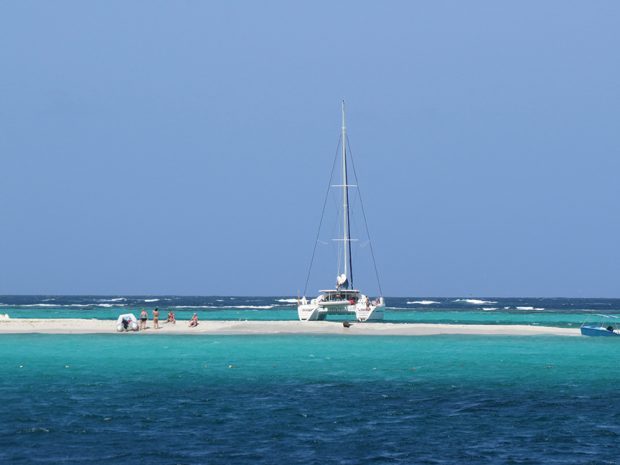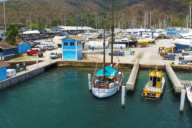Previously published in BWS by Zuzana Prochazka.
Ever wonder if sailing school is for you? Here’s what it’s like to spend a week in hands-on training where teachable moments come hard and fast.

We really only had one shot at the next move. On the wheel, Doug brought us head to wind as Yi pulled hard on the furling line to get the jib in before the sheets beat Jon, on the bow, to a pulp. My job was easy. I had to luff the mainsail so we would come to a stop while Jon hand-over-handed 120 feet of chain out of the locker because the free-fall on the windlass was inoperable. We drifted back, happy to see the chain grow taut as the anchor dug in. This was definitely extra credit.he tack was clean and snappy and sent plumes of foam off our wake. We sliced below a parked catamaran and I just caught the wide-eyed look on the face of its owner as we zipped by into the anchorage where a 20 knot breeze was kicking up whitecaps.
Anchoring under sail in sporty conditions isn’t on the American Sailing Association curriculum. It was also not on the LTD Sailing School’s itinerary to return to Carriacou after clawing our way to windward for five hours only to give up the same ground in two hours of running downwind. Our attempt to get to Petite Martinique that day was interrupted when we discovered we had no engine. The starter was out. Done. Kaput. Cleaning the wires (which was a teachable moment earlier in the week) and knocking on it with a wrench wasn’t going to work this time.
LTD Sailing instructor Jon Totten made the call to return to our previous night’s anchorage for a couple of reasons. Skirting the reefs of the Southern Grenadines while beating into 25-30 knots and six foot seas wasn’t an ideal situation. Besides, assistance would be easier to come by in a bigger town like Tyrrel Bay. Today’s lesson—thinking only one step ahead may not be enough.
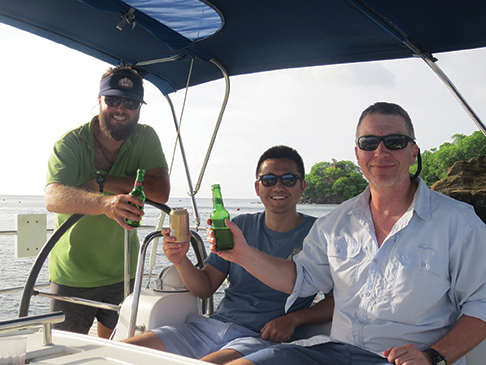
It was dusk when we finished and no help was coming until morning. But we were hooked up safely so it was time for a “we’re here beer” although technically, we were “here”—again. I was on a ride-along on LTD Sailing’s weeklong advanced program that offers ASA 105 Coastal Navigation and 106 Advanced Coastal Cruising certifications on charter vessels. LTD Sailing is a school based in Grenada and does basic and advanced sail training. It is owned and operated by Chris Rundlett and Chrystal Young, two Americans who quit their jobs to “live the dream”, thus “LTD”.
They have built a reputation as a premium school in a place where few newbies venture. This attracted Doug, a geographic information systems consultant from Colorado with an instinctive feel for the wind from his windsurfing background, and Yi, a statistics professor based in Canada who had been honing his skills for two years in colder climes. They both signed up with LTD Sailing, not only to get the experience of big wind and water in the Windward Isles, but also to switch up their training. Both had gotten their primary certifications with other schools in locations where conditions were more benign and now they were up for a challenge. Besides, sailing in Grenada and up into the Grenadines was a way to get to know new cruising grounds, learn a lot, and have a tropical vacation to boot.
THE MAKING OF THE SCHOOL
Chris and Chrystal met in prison. He was a correctional officer and she worked in the training department. Chris already loved sailing and when prison life got to be too much, he became a sailing instructor in Seattle. While enjoying racing and cruising around Washington and Idaho, he met individuals like Jon, a river guide and coordinator of outdoor pursuits at North Idaho College with a master’s degree in adult education, who eventually became one of LTD’s instructors.
After first working in St. Vincent for a few years, Chris learned that successfully navigating the intricacies of doing business in a foreign country was more manageable in Grenada. That’s when Chrystal quit her job, sold her house and cashed in to join him as director of operations and co-owner. Her degree in outdoor leadership came in handy. It was a leap of faith for both and, like the rainy season squalls, their teachable moments came with full force and high frequency.
Three years later, their school thrives and their premium brand is a point of differentiation. There’s no rubber-stamping of credentials or ferrying students around a few islands while they enjoy a leisurely vacation. “I did my research and read a lot of books and issues of The Harvard Business Review to figure out how to build a better business,” says Chris. “We are targeting people who really want to learn from the best where, at the end of the day, the depth and breadth of education is even more valuable than the certification.”
Chrystal’s personal touch makes all the difference to a high-end experience. She manages student and vendor communications, provisions for specific needs, provides airport pickup, does the marketing and generally keeps things running smoothly in a land where efficiency is not always easy to come by. “Not having to deal with the details helps students arrive fresh and focused on the task of learning,” added Chrystal. “We aim to make ours a comprehensive experience without the headaches.”
THE MISSION CONTINUES
As we waited for the new starter to be flown in, it was a perfect time to dig out the books and study the theory portion of the course. Our classroom was a Beneteau 43.3 chartered from The Moorings. It was a good boat that sailed well and was set up for easy reefing, a must in a place where 25 knots is common. By that afternoon, with the help of the island mechanic, we were on our way once more.
SKILLS AND DRILLS
When I came aboard a few days earlier, Doug and Yi had already spent time getting initiated. They had learned the boat systems including power and waste management. They dialed in reefing in a place where reefing is the norm and they navigated in and out of a channel with buoys and range markers. They also located and caught a mooring in the dark.
I joined via dinghy at exam time. Charts were spread out on the saloon table and there was much talk of running fixes and set and drift. As we sailed up Grenada’s lee side, conditions were hot and bumpy below and more than once, a head popped up for air before disappearing below to plot another position. As we cleared the northern tip of Grenada, the wind piped up to 30 knots and another reef was added.
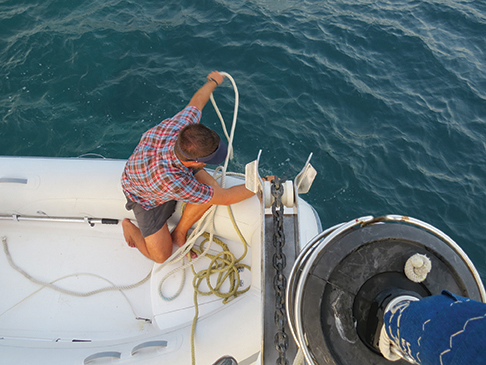
Although technically a part of the country of Grenada, Carriacou and its neighboring islands are more like the Grenadines that, together with St. Vincent, form the next country to the north. It’s an ideal teaching ground with many landmarks, reefs and even a submerged volcano near Isle de Ronde and Kick ‘Em Jenny islands.
The boat was easy to manage but we couldn’t get too comfortable because soon Frankie made an appearance. A five-gallon jug filled with seawater attached to a PFD, Frankie was tossed into the drink for a man-overboard situation. In the windy conditions, the jug kept the vest from flying away and simulated the drift of a human body. Jon teaches a modified quick stop technique and after doing the recovery a few times under sail myself, I was impressed with this new move.
That night, we anchored at picturesque Sandy Island and cooked chicken curry—no canned stew for this bunch. Everyone pitched in and we were bonding as a crew.
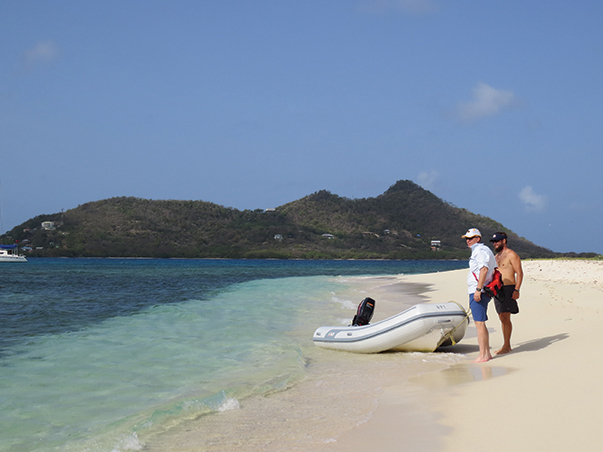
After flushing the water tanks that had taken on an unappealing funk, we set sail from Petite Martinique to the Tobago Cays, squeezing between Palm and Union islands on a lovely beam reach. We sailed up past Mopion, a low sand island with a single thatch palapa that sometimes gets washed away, and waved to Janti’s Happy Island, a beach built entirely of conch shells that supports a single bar, perfect for sundowners.
We squeezed between the Catholic Rocks and Mayreau Island and turned southeast toward the Cays, a Grenadines highlight, where turtles swim within an arm’s length and stingrays hang out in the shadow of the boat. The surrounding Horseshoe Reef keeps the water calm and perfect for snorkeling so we took time out to enjoy, because this school is about the whole experience of cruising, not just the hard work.
The white sand beaches of the Cays may look familiar since parts of the movie Pirates of the Caribbean were filmed there. Local entrepreneurs in colorful launches come by offering their wares and we supported the economy by purchasing the requisite T-shirt or two.
THE NIGHT SHIFT
The last orange streaks of light faded from the sky as we reached the lee of Glossy Hill on Canouan Island on the fifth day. It was time for the night sail and another visit by Frankie, this time with an attached strobe, so we could find our man in the inky water. On my turn, the light got tangled under the vest and was virtually invisible. Another lesson; never take your eyes off of the victim, especially in the dark.
Our sail south that evening was under a full moon in 15-25 knots of wind. As we dodged rocks, islands, tankers and ferries, we hit just about every point of sail. We mostly stayed three miles off the islands and stood two-hour watches until seven the next morning. The beauty of sailing on a glistening ocean at night is a real treat and Doug and Yi seemed immersed in the experience.
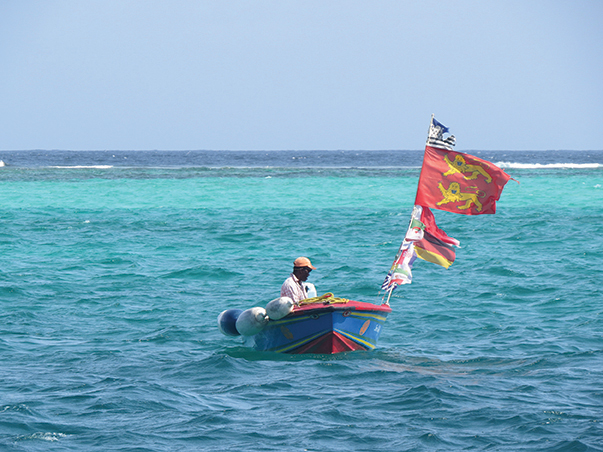
By morning, we reached the southern tip of Grenada. It was time for some rest, a review of the written exams and one more lesson on what seems to be the single most intimidating part of boating- docking. Jon’s local knowledge of suitable docks for practice led us to Secret Harbor in Mt. Hartman Bay. With the Porpoise Rocks hazard outside the entrance, and menacing looking reefs to port and starboard, it was a lesson in navigation just to get in. Straining their eyes to find the small markers bobbing between rollers, the guys threaded the needle on the approach and demonstrated the teamwork that had developed over the week.
Touch-and-go landings were repeated a few times at the fuel dock and Jon even snuck in some Med mooring practice. Although that’s definitely not on the normal curriculum even for advanced courses, tying up stern-to is often necessary in the Caribbean and usually brings about the sweats in a nervous skipper. With this demonstration, Doug and Yi should be a little less tense when they encounter this on their own charters.
For the last night, we caught a mooring at Moliniere Point, next to the underwater sculpture park. This art installation is the work of Jason deCairs Taylor who has put statues underwater at numerous islands. Grenada’s was the British artist’s first gallery, aiming to create an artificial reef as a marine life refuge after hurricane Ivan devastated the area in 2004. It was a fun finish to a week of serious learning.
We said goodbye at the dock in Port Louis marina in the quaint city of St. George’s. Both students had already set their sights on a charter of their own—Yi in the Chesapeake just a few weeks away, and Doug in the British Virgin Islands with his family.
STRAIGHT UP INSPIRATION
Not everyone is going to sell up and make teaching sailing in the Caribbean their career. And not everyone who takes a class will sail around the world on their own boat. But these people are not just sitting at the yacht club telling tales of adventures yet to come. They’re actually doing it and that is, in Jon’s words, “straight up inspiration”.
Sailing school isn’t only for newcomers. There are many reasons why even salty dogs can benefit from additional training. Learning new cruising grounds, adjusting to life aboard for more than a daysail, getting used to the huge forces on big boats in spirited conditions, are all reasons to come learn. Doug and Yi ran down a long list of why they were there, testing their mettle in this watery classroom. (See sidebar.)
“This was certainly a thorough tour of the Southern Grenadines,” said Doug who was often on deck with his camera. “It’s so beautiful and there couldn’t be a better place for an advanced course.”
Yi’s compelling reason for choosing LTD Sailing’s continuing education was to share his love of sailing with people in China, a fast-growing market for sailing instruction. “My friends don’t understand why I do this so I want to tell them what an amazing thing sailing can be.”
For many of us, perhaps the most satisfying part of learning to run a boat in challenging, real-life conditions is the sense of self-sufficiency gained via endless teachable moments that present themselves one after another. It’s thoroughly satisfying to amass a list of accomplishments in just a few days. Spending a week in beautiful cruising grounds doesn’t hurt either.
Zuzana Prochazka is a veteran cruiser and freelance writer. She is based in Southern California.
TEN TIPS FOR BEST RESULTS WHEN
JOINING A SAILING SCHOOL PROGRAM
Get a grasp of your goals and make a list of what you want from the experience. Communicate these to the school so they can tailor your adventure as much as possible.
Manage your expectations. You are on vacation but you are also in training. You will need to balance the two to make the most of your week.
Decide whether to share your experience with friends or family by booking a whole boat and instructor, or save some money and meet other students on a mixed trip put together by the school.
Google is your friend. Start by searching for sailing schools in your preferred area. If you want to go with a formal program like ASA or U.S. Sailing, search their Web sites for schools and locations and then thoroughly review the school’s individual Web sites.
Ask the school for an itinerary, background information on the area, instructor bio and an overview of the curriculum. Fewer surprises lead to better experiences.
Be prepared and don’t wing it. A good school doesn’t just stamp credentials and will expect you to pre-study to be ready for hands-on training when you arrive. The instructor, as well as your fellow students, will appreciate your preparation.
Although most people book four to six weeks ahead, the best schools are busy during the high season so a few months lead time is your best bet to getting the schedule you want. This also gives you time to study.
Read reviews online, check out TripAdvisor and Yelp and call the school to get a feel for the personnel. If your initial contact leaves you with a good impression, the chances are good you will have a more personal and meaningful experience overall.
Don’t discount your fellow students as a source of education. People come in with different strengths and can really add to your training.
Mix up your training by taking classes with different instructors or schools. Switching up locations will put you in different wind and wave conditions so you develop a broader set of experiences and skills.
A DOZEN REASONS TO GO TO SAILING SCHOOL
Formal instruction tends to develop broader skills and good habits, and it will help you learn faster than just going it alone.
The certification you acquire will build your sailing resume for when you want to charter on your own. Some European countries now require proof of competency and most charter companies will want to see your resume before booking a bareboat.
Schools are not just for newbies. If it’s been awhile since you were on the water, refreshing your skills in a school is a fast review and you’ll probably learn new things as well.
Sailing school can be a great bonding activity for couples or families. Check the minimum age of student that a school will accept and make sure everyone is really on board with the plan, or the bonding won’t go so well.
A sailing school can help prepare you for boat ownership or for extended cruising. Spending a week or two aboard at a time is a completely different experience from day sailing so get a preview before making a large commitment.
In school, you can get out of your comfort zone but still stay safe. Lose that sailing rut and stretch your skills under the watchful eye of a knowledgeable guide.
Sailing schools in exotic places can be an affordable way to get to know new cruising grounds. The local knowledge you’ll gain may come in handy if you charter there later.
Sailing school is a great way to meet like-minded people and potentially make new friends and tap into future sailing buddies.
Sailing isn’t the only thing to learn in sailing school. Docking, anchoring, maneuvering under power and safety procedures like recovering a man-overboard are essential skills for all boaters. Add to that managing complex modern boat systems, conserving water and power, meal preparation under way, and living aboard in close quarters with others and you’ve got a full week at least.
Graduating to larger boats in tougher weather and conditions is best done with instruction. Whether you are stepping up to boats 40 feet or larger, toying with the idea of chartering a catamaran or just interested in handling a big boat with big forces on the sails and equipment, learning from a pro keeps things under control.
Following a formal curriculum in a multi-level program like ASA, provides consistency of material and progression of learning. It means you leave very little to chance and attempt skills way beyond what you’d pursue learning on your own.
Enjoying the “we’re here beer” at the end of the day in a new anchorage with your fellow students is a great way to renew your love of sailing and get you back on the water.

